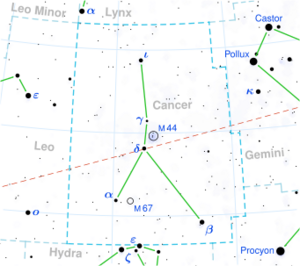Astronomy:LHS 2090
From HandWiki
Coordinates: ![]() 09h 00m 23.594s, +21° 50′ 05.43″
09h 00m 23.594s, +21° 50′ 05.43″
| Observation data Equinox J2000.0]] (ICRS) | |
|---|---|
| Constellation | Cancer |
| Right ascension | 09h 00m 23.594s[1] |
| Declination | +21° 50′ 05.43″[1] |
| Apparent magnitude (V) | 16.11[2] |
| Characteristics | |
| Evolutionary stage | Main-sequence star[2] |
| Spectral type | M6.5 V[3] |
| Apparent magnitude (J) | 9.44[2] |
| Astrometry | |
| Radial velocity (Rv) | 23.3[2] km/s |
| Proper motion (μ) | RA: -514.942[4] mas/yr Dec.: -592.253[4] mas/yr |
| Parallax (π) | 157.2686 ± 0.0535 mas |
| Distance | 20.739 ± 0.007 ly (6.359 ± 0.002 pc) |
| Details | |
| Mass | 0.09[5] M☉ |
| Radius | 0.12[6] R☉ |
| Luminosity | 0.00082[7] L☉ |
| Temperature | 2680±24[7] K |
| Metallicity [Fe/H] | -0.06±0.17[8] dex |
| Rotation | 0.439 d[6] |
| Rotational velocity (v sin i) | 15.0±1.0[6] km/s |
| Other designations | |
| Database references | |
| SIMBAD | data |
Location of LHS 2090 in the constellation Cancer | |
LHS 2090 is a red dwarf star of spectral type M6.5V, located in constellation Cancer at 20.8 light-years from Earth.[10]
The star was identified to be a red dwarf at short distance (6 parsecs from Sun) in 2001.[11] As typical for very cool red dwarfs, its spectrum is dominated by molecular water absorption. Stellar metallicity is similar to that of Sun`s.[8]
Radial velocity measurements did not yield any detection of stellar companion or giant planet on orbit around LHS 2090, as in 2018.[2]
References
- ↑ 1.0 1.1 Cutri, R. M. (2003). "2MASS All-Sky Catalog of Point Sources". VizieR On-line Data Catalog. Bibcode: 2003yCat.2246....0C.
- ↑ 2.0 2.1 2.2 2.3 2.4 Henry, Todd J.; Jao, Wei-Chun; Winters, Jennifer G.; Dieterich, Sergio B.; Finch, Charlie T.; Ianna, Philip A.; Riedel, Adric R.; Silverstein, Michele L. et al. (2018), "The Solar Neighborhood XLIV: RECONS Discoveries within 10 parsecs", The Astronomical Journal 155 (6): 265, doi:10.3847/1538-3881/aac262, Bibcode: 2018AJ....155..265H
- ↑ Alonso-Floriano, F. J.; Morales, J. C.; Caballero, J. A.; Montes, D.; Klutsch, A.; Mundt, R.; Cortés-Contreras, M.; Ribas, I. et al. (2015). "CARMENES input catalogue of M dwarfs". Astronomy & Astrophysics 577: A128. doi:10.1051/0004-6361/201525803. Bibcode: 2015A&A...577A.128A. http://goedoc.uni-goettingen.de/goescholar/bitstream/handle/1/12402/aa25803-15.pdf.
- ↑ Brown, A. G. A. (2021). "Gaia Early Data Release 3: Summary of the contents and survey properties". Astronomy & Astrophysics 649: A1. doi:10.1051/0004-6361/202039657. Bibcode: 2021A&A...649A...1G. Gaia EDR3 record for this source at VizieR.
- ↑ Davison, Cassy L.; White, R. J.; Henry, T. J.; Riedel, A. R.; Jao, W-C.; Bailey Iii, J. I.; Quinn, S. N.; Cantrell, J. R. et al. (2015), "A 3D Search for Companions to 12 Nearby M Dwarfs", The Astronomical Journal 149 (3): 106, doi:10.1088/0004-6256/149/3/106, Bibcode: 2015AJ....149..106D
- ↑ 6.0 6.1 6.2 Fouqué, Pascal et al. (April 2018), "SPIRou Input Catalogue: global properties of 440 M dwarfs observed with ESPaDOnS at CFHT", Monthly Notices of the Royal Astronomical Society 475 (2): 1960–1986, doi:10.1093/mnras/stx3246, Bibcode: 2018MNRAS.475.1960F.
- ↑ 7.0 7.1 Dieterich, Sergio B.; Henry, Todd J.; Jao, Wei-Chun; Winters, Jennifer G.; Hosey, Altonio D.; Riedel, Adric R.; Subasavage, John P. (2013), "The Solar Neighborhood. Xxxii. The Hydrogen Burning Limit", The Astronomical Journal 147 (5): 94, doi:10.1088/0004-6256/147/5/94
- ↑ 8.0 8.1 Rojas-Ayala, Bárbara; Covey, Kevin R.; Muirhead, Philip S.; Lloyd, James P. (2011), "Metallicity and Temperature Indicators in M Dwarfk-Band Spectra: Testing New and Updated Calibrations with Observations of 133 Solar Neighborhood M Dwarfs", The Astrophysical Journal 748 (2): 93, doi:10.1088/0004-637X/748/2/93
- ↑ "LHS 2090". SIMBAD. Centre de données astronomiques de Strasbourg. http://simbad.u-strasbg.fr/simbad/sim-basic?Ident=LHS+2090.
- ↑ Henry, T. J.; Jao, Wei-Chun; Subasavage, John P.; Beaulieu, Thomas D.; Ianna, Philip A.; Costa, Edgardo; Méndez, René A. (2006). "The Solar Neighborhood. XVII. Parallax Results from the CTIOPI 0.9 m Program: 20 New Members of the RECONS 10 Parsec Sample". The Astronomical Journal 132 (6): 2360–2371. doi:10.1086/508233. Bibcode: 2006AJ....132.2360H. http://repositorio.uchile.cl/bitstream/2250/126230/1/Henry_Todd.pdf.
- ↑ Scholz, R.-D.; Meusinger, H.; Jahreiß, H. (2001), "Search for nearby stars among proper motion stars selected by optical-to-infrared photometry", Astronomy & Astrophysics 374 (2): L12–L15, doi:10.1051/0004-6361:20010811
 |


